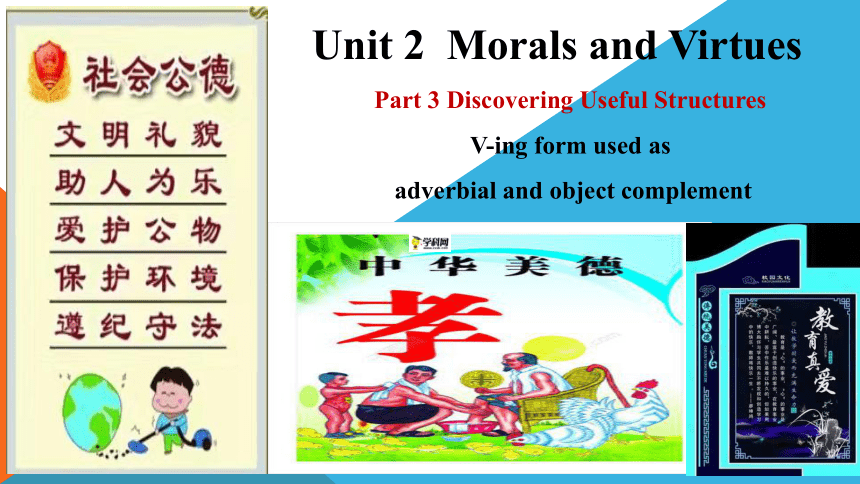(
课件网) Unit 2 Morals and Virtues Part 3 Discovering Useful Structures V-ing form used as adverbial and object complement Teaching goals 1.To learn the usage of V-ing form used as adverbial or object complement in a sentence. 2.To apply what we learn in this period to exercises, especially in writing, and grammar filling. 1) Hearing the bell, the students began to enter the classroom. 2) Not knowing the answer to this question , he turned to his deskmate. 3) The two girl stood there for half an hour talking about the boys who were playing basketball. 4) The COVID-19 broke out throughout the world, causing hundreds of thousands of deaths. 5) Working harder, you will make some progress. 3.读句子,思考以下问题: ①. V-ing 作状语可以表示哪些情况? ②. V-ing 作状语应注意什么? 时间状语=when... 原因状语=because... 伴随状语=and ... 结果状语 =which caused... 条件状语=if... Attention 1: V-ing 作状语,相当于_____。 一个状语从句(并列句) Attention 2: V-ing 作状语时,它的逻辑主语必须是_____, 分词必须和句中的主语含有逻辑上的_____。 句子的主语 主谓关系 1. Read the sentences below and pay attention to the underlined parts. 1. … her brother complained, thinking of the high tuition fees. 2. Thinking of all the people still in need of help, Dr Lin opened a private clinic. 3. The new People's Republic of China saw Dr Lin Qiaozhi playing a key role. 4. At times she was even seen riding a donkey to faraway villiage to provide medical care. 1. thinking→adverbial 2. thinking→adverbial 3. playing→object complement 4. riding→object complement 1.-ing形式作状语时, 分词的逻辑主语必须是句子的主语, 分词必须和句中的主语含有逻辑上的主谓关系, 否则不能用 现在分词作状语。但要注意它的各种形式变化: 主动形式 被动形式 一般式 V-ing being V-ed 完成式 having V-ed having been V-ed -ing形式作状语 1.作时间状语 Walking in the park,she saw an old friend. =When/while(she was)walking in the park,she saw an old friend. 当她在公园里散步时,她看到了她的一个老朋友。 Having finished the work,he went to see his teacher. =After he had finished the work,he went to see his teacher. 完成这次工作后,他去看望他的老师。 【特别提示】当表达正在进行的动作时,可直接在分词前面加上when/while,此时也可理解为状语从句的省略。 2.作原因状语 Being ill,he couldn't go to school. =As he was ill,he couldn't go to school. 3.作条件状语 Working hard,you'll make great progress. =If you work hard,you'll make great progress. 4.作结果状语 His parents died,leaving him an orphan. =His parents died and left him an orphan. The snow lasted a week,resulting in a serious traffic confusion in the whole area. =The snow lasted a week,and resulted in a serious traffic confusion in the whole area. 5.作方式状语 He came running back to tell me the news. 6.作伴随状语 I stood by the door,not daring to say a word. =I stood by the door,and didn’t dare to say a word. She walked along the street,singing softly to herself. =She walked along the street and sang s ... ...

